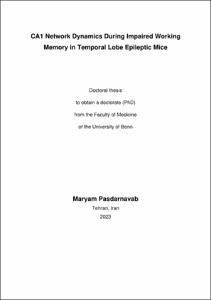Pasdarnavab, Maryam: CA1 Network Dynamics During Impaired Working Memory in Temporal Lobe Epileptic Mice. - Bonn, 2023. - Dissertation, Rheinische Friedrich-Wilhelms-Universität Bonn.
Online-Ausgabe in bonndoc: https://nbn-resolving.org/urn:nbn:de:hbz:5-71061
Online-Ausgabe in bonndoc: https://nbn-resolving.org/urn:nbn:de:hbz:5-71061
@phdthesis{handle:20.500.11811/10880,
urn: https://nbn-resolving.org/urn:nbn:de:hbz:5-71061,
author = {{Maryam Pasdarnavab}},
title = {CA1 Network Dynamics During Impaired Working Memory in Temporal Lobe Epileptic Mice},
school = {Rheinische Friedrich-Wilhelms-Universität Bonn},
year = 2023,
month = jun,
note = {Around 50 million people worldwide suffer from epilepsy. Seizures are not the only feature of epilepsy that patients suffer from. Despite the fact that other comorbidities of epilepsy such as memory deficits widely impact a patient's life, they are not the target of common treatments since they have been associated with hippocampal sclerosis and seizure burden.
In this study, we used in vivo electrophysiology to investigate the hippocampal neuronal network changes underlying memory deficits in temporal lobe epileptic mice, the most common form of pharmacoresistant epilepsy in adults. We aim to show seizures and memory impairments are two separate symptoms of temporal lobe epilepsy (TLE).
Kainic acid (KA) epilepsy-induced mice showed a deficit in performing a hippocampal-dependent spatial working memory task. Our data showed that memory deficits in epileptic mice are not related to epileptiform event burdens or duration. Furthermore, we showed that epileptic mice experience frequent focal rhythmic discharges (FRDs, subclinical seizures longer than 2 s). For the first time, we showed that these FRDs are spatially modulated. Interestingly, FRDs being spatially stable is correlated to memory performance meaning that the timing of the FRD occurrence plays a more important role than their frequency or duration. Moreover, our data suggest that FRDs overlap with sharp wave ripples (SWRs) in spectrum features and the occurrence zone on the maze. This finding suggests that FRDs and SWRs are originating from a similar neuronal network to SWRs in healthy mice.
Investigating the CA1 network changes underlying TLE, we found a theta power reduction in the hippocampus of the KA injected side (right hippocampus) while the contralateral hippocampus remained healthy. We also showed synchronization between two hippocampi CA1 across the theta frequency band is reduced in epileptic mice. This theta coherence reduction is correlated to memory performance.},
url = {https://hdl.handle.net/20.500.11811/10880}
}
urn: https://nbn-resolving.org/urn:nbn:de:hbz:5-71061,
author = {{Maryam Pasdarnavab}},
title = {CA1 Network Dynamics During Impaired Working Memory in Temporal Lobe Epileptic Mice},
school = {Rheinische Friedrich-Wilhelms-Universität Bonn},
year = 2023,
month = jun,
note = {Around 50 million people worldwide suffer from epilepsy. Seizures are not the only feature of epilepsy that patients suffer from. Despite the fact that other comorbidities of epilepsy such as memory deficits widely impact a patient's life, they are not the target of common treatments since they have been associated with hippocampal sclerosis and seizure burden.
In this study, we used in vivo electrophysiology to investigate the hippocampal neuronal network changes underlying memory deficits in temporal lobe epileptic mice, the most common form of pharmacoresistant epilepsy in adults. We aim to show seizures and memory impairments are two separate symptoms of temporal lobe epilepsy (TLE).
Kainic acid (KA) epilepsy-induced mice showed a deficit in performing a hippocampal-dependent spatial working memory task. Our data showed that memory deficits in epileptic mice are not related to epileptiform event burdens or duration. Furthermore, we showed that epileptic mice experience frequent focal rhythmic discharges (FRDs, subclinical seizures longer than 2 s). For the first time, we showed that these FRDs are spatially modulated. Interestingly, FRDs being spatially stable is correlated to memory performance meaning that the timing of the FRD occurrence plays a more important role than their frequency or duration. Moreover, our data suggest that FRDs overlap with sharp wave ripples (SWRs) in spectrum features and the occurrence zone on the maze. This finding suggests that FRDs and SWRs are originating from a similar neuronal network to SWRs in healthy mice.
Investigating the CA1 network changes underlying TLE, we found a theta power reduction in the hippocampus of the KA injected side (right hippocampus) while the contralateral hippocampus remained healthy. We also showed synchronization between two hippocampi CA1 across the theta frequency band is reduced in epileptic mice. This theta coherence reduction is correlated to memory performance.},
url = {https://hdl.handle.net/20.500.11811/10880}
}






